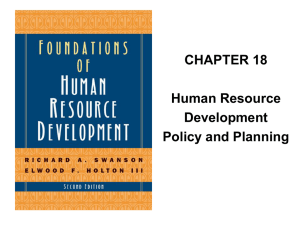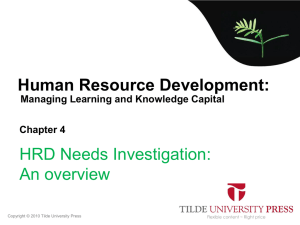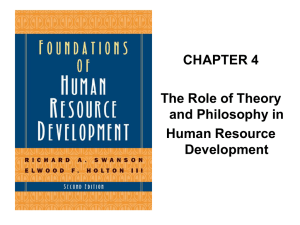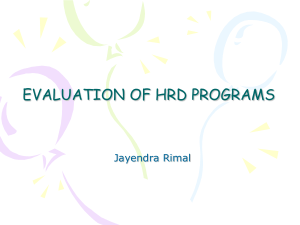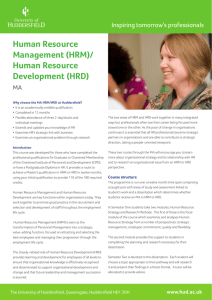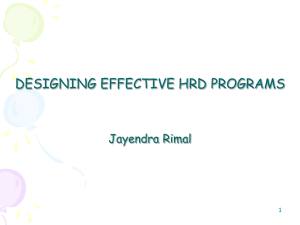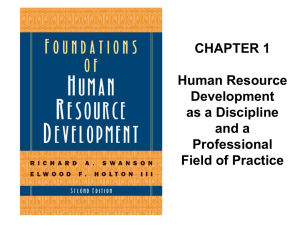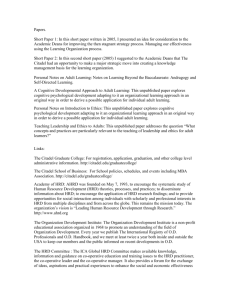Criticallly challenging some assumptions in HRD
advertisement
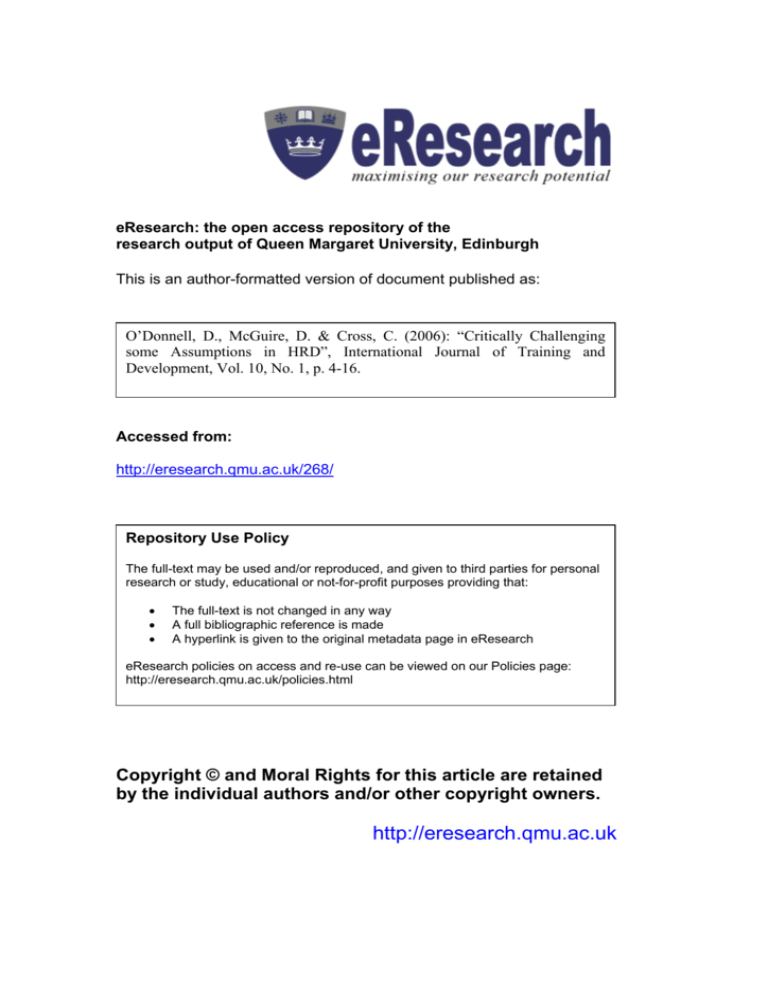
eResearch: the open access repository of the research output of Queen Margaret University, Edinburgh This is an author-formatted version of document published as: O’Donnell, D., McGuire, D. & Cross, C. (2006): “Critically Challenging some Assumptions in HRD”, International Journal of Training and Development, Vol. 10, No. 1, p. 4-16. Accessed from: http://eresearch.qmu.ac.uk/268/ Repository Use Policy The full-text may be used and/or reproduced, and given to third parties for personal research or study, educational or not-for-profit purposes providing that: • • • The full-text is not changed in any way A full bibliographic reference is made A hyperlink is given to the original metadata page in eResearch eResearch policies on access and re-use can be viewed on our Policies page: http://eresearch.qmu.ac.uk/policies.html Copyright © and Moral Rights for this article are retained by the individual authors and/or other copyright owners. http://eresearch.qmu.ac.uk CRITICALLY CHALLENGING SOME ASSUMPTIONS IN HRD David O’Donnell, David McGuire and Christine Cross David O'Donnell Intellectual Capital Research Institute of Ireland Ballyagran, Limerick County, Ireland. Tel: +353 876821032 Email: david.odonnell@ireland.com David McGuire (Corresponding author) School of Management, Napier University Business School, Craiglockhart Campus, 219 Colinton Road, Edinburgh, EH14 1DJ, Scotland. Tel: +44 1314554340 Email: d.mcguire@napier.ac.uk Christine Cross Department of Personnel & Employment Relations, Kemmy Business School, University of Limerick, National Technological Park, Limerick, Ireland. Tel: + 353 61 203086 Email: christine.cross@ul.ie Reference as: O’Donnell, D., McGuire, D. & Cross, C. (2006): “Critically Challenging some Assumptions in HRD”, International Journal of Training and Development, Vol. 10, No. 1, p. 4-16. 0 CRITICALLY CHALLENGING SOME ASSUMPTIONS IN HRD Abstract This paper sets out to critically challenge five inter-related assumptions prominent in the HRD literature. These relate to: the exploitation of labour in enhancing shareholder value; the view that employees are co-contributors to and co-recipients of HRD benefits; the distinction between HRD and HRM; the relationship between HRD and unitarism; and, the relationship between HRD and organisational and learning cultures. From a critical modernist perspective, it is argued that these can only be adequately addressed by taking a point of departure from the particular state of the capital-labour relation in time, place and space. HRD, of its nature, exists in a continuous state of dialectical tension between capital and labour—and there is much that critical scholarship has yet to do in informing practitioners about how they might manage and cope with such tension. Key words capital-labour relation; employment relation; HRD; critical modernism Introduction In recent times the employment relation in organisations is deemed to have become more informal, apparently consensual, and loosely democratic. Human resource development (HRD), at first glance, appears to be very much at home in this comfortable and apparently sophisticated and progressive milieu. Notwithstanding the unquestioned ascendancy of neo-liberal forms of capitalism in the developed world, the idea of ‘critical intent’ did not disappear simultaneously with the collapse of the Berlin Wall in 1989. A change in global politics?—yes; in the fundamental nature of economy and society?— probably not. HRD has emerged as a complex heterogeneous field serving many constituencies with diverse purposes. This multiplicity of purposes has led to questioning about whether HRD is concerned with developing such ‘resources’ for the benefit of employees or for the benefit of organisations, or both. This form of questioning implicitly assumes benefits accruing to both employees and organisations from engaging in HRD, but does not determine either the nature or proportionality of such benefits within the employment relationship, or whether this relationship is itself changing. To be more critically precise—does HRD serve capital or labour? This is not a simple binary—the capitallabour relation is complex and is subject to a range of personal, historical, local, national, global and ideological forces and mediations. Acknowledging this complexity, we do not attempt to address the HRD field as a whole, but pragmatically focus here on a small number of key assumptions prominent within the field. These relate to: (i) the instrumental exploitation of employees to drive organisational performance and enhance shareholder value; (ii) the view that employees are co-contributors to and co-recipients of HRD benefits; (iii) the distinction between HRD and HRM; (iv) the perceived distance of HRD from the unitarist HRM agenda; and (v), the view that HRD interventions are effective in the creation of positive organisational and learning cultures and in the inculcation of organisational norms and values. The structure of the remainder of this paper is as follows. Firstly we set our discussion in the context of the broader HRD literature and introduce our critical modernist intent; the assumptions noted above, which in many ways are inter-related, are 1 then presented and subjected to an initial critique; from a critical modernist perspective we argue strongly that these can only be adequately addressed by taking a point of departure from the particular state of the capital-labour relation in time, place and space. We conclude that HRD, of its nature, exists in a continuous state of dialectical tension— but that critical HRD scholars have yet to adequately inform practitioners about how such critical discourse is relevant, and more importantly, how practitioners might cope with such tensions and draw on critical insights in informing their everyday HRD practices. Beyond essentialism—How is HRD? Schluchter (1987) notes the relation between increasing rationalization in the economic sphere and the expansion of forms of ‘functional authority’, such authority based largely on expertise, competence or know-how. Such know-how is linked to actor knowledge, or to specific networks of actors, and not to particular organisational positions, ‘official authority’, as in the heyday of bureaucratic Taylorism. In contrast to de-skilling, which remains central in numerous industrial sectors, the emergence of knowledge-intensive labour leads to structural problems in bureaucratic organisations as they try to move from hierarchies towards teams, networks and forms of selfmanagement and selves-development (O’Donnell, 1999). This leads to the vexed relation between management and employee development and the extent to which theories of human resource development (HRD), human resource management (HRM) and knowledge management (KM) are “latently strategic” in Habermasian (1987) terms or ideological in that they serve particular interests. We adopt a critical modernist slant on HRD here. What is HRD? The call for papers for this special issue provides a generalist definition of HRD as being concerned with “supporting and facilitating the learning of individuals, groups and organisations” (McGoldrick, Stewart and Watson, 2002: 396). Many other answers are possible to this essentialist question dependent on one’s worldview. Where is HRD? Is it, for example, located at the dynamic and co-creative elements of the bi-polar dimensions of self–other and agency–structure (Lee, 2003)? Or perhaps there is no theory of HRD as such, as one is not really necessary given the existence of numerous theoretical approaches that claim to explain human behavior (Stewart, 2003). These authors acknowledge that HRD is constituted by an openness and fluidity and is concerned with how individuals interact with their environments, moving away from what Rigg and Trehan (2004) see as the narrow instrumental definitions of HRD as “training” that permeate much of the extant literature. Essentialist “what is?” questions, however, cannot fully disclose HRD to us (Henriksen et al., 2004). How is HRD? HRD may be viewed as a negotiated reality of shared meanings (Gunnarsson, 1997; Nermeyer and Stewart, 1998) that, somehow, becomes accepted as a purposeful activity within organisational contexts. These meanings are constructed through the medium of language within particular organisational lifeworlds and in academic and practitioner discourses. The objective of any critical examination of HRD, therefore, begins with an analysis of how HRD is talked about or perceived with a view to identifying areas in which it is used for the purposes of control, domination, oppression and exploitation. This is the system-lifeworld dialectic at the heart of critical theory from Marx to Horkeimer and Adorno, and more recently from Habermas to Honneth. Poststructuralism, often following Foucauldian insights on power, provides another 2 avenue of critique for those wishing to adopt a postmodernist stance (see Alvesson and Deetz, 1996; Gabriel, 2001; Townley, 1994; Trehan, 2004)—but in this paper, following Mezirow’s (1981) seminal introduction, we situate our critical discussion of HRD broadly within the Frankfurt School critical modernist tradition. Where is HRD? In our view, it is at home somewhere within the capital-labour relation; a basic insight so obvious that it is rarely made explicit in HRD discourse. Having located HRD in theoretical space, we can now address it in order to find out how it is. Following Brookfield (1987), critical thinking is not an abstract process confined to academic settings but an activity embedded in the ordinary everyday organisational contexts of mundane employee and HRD practitioner lives. A critical modernist approach to HRD, in maintaining faith in the original emancipatory intent of critical theory, aspires to nothing less than individual, organisational and societal transformation (Brookfield, 1987, 2001; Fenwick, 2004; Mezirow, 1981; O’Donnell, 1999; Trehan and Longmore, 2004; Young, 1989). Critically addressing some HRD assumptions Where do we begin our critique? Fenwick (2004: 194) notes that: ... erroneous assumptions of an identifiable HRD have created an illusionary entity that is unified and fixed as an impenetrable opponent—a perspective that fails to recognize its heterogeneous and fluid character. Adopting a pragmatic critical modernist stance, this paper subjects five such assumptions on HRD to an initial examination. These relate to: (i) the instrumental exploitation of employees to drive organisational performance and enhance shareholder value; (ii) the view that employees are co-contributors to and co-recipients of HRD benefits; (iii) the distinction between HRD and HRM; (iv) the perceived distance of HRD from the unitarist HRM agenda; and (v), the view that HRD interventions are effective in the creation of positive organisational and learning cultures and in the inculcation of organisational norms and values. These assumptions are far from being totally distinct; they inter-penetrate and influence each other and in our discussion we attempt to ground our examination of each in the simultaneously universal, particular and dynamic nature of the employment relation in time, place and space. We seek merely to surface the implicit, often unspoken, agendas of power, exploitation and control that often lie beneath the cosy, overly humanist and unitarist surface exterior of much HRD discourse and practice by explicitly situating HRD within the capital-labour relation. Some discontinuities between the various rhetorics and realities of HRD are surfaced and exposed here and certain control mechanisms and ideological discourses identified. We do not attempt to present any naïve or premature conclusions in this paper—its general purpose is to raise the consciousness and awareness levels of both academics and practitioners by subjecting these particular assumptions to an initial critique. Nor do we address here the core practical issue of how the critical insights raised might be appropriated by HRD practitioners and, somehow, influence their everyday professional practices. 3 Assumption-1: HRD involves the instrumental exploitation of employees to drive organisational performance and enhance shareholder value The performance paradigm has been, is, and, for the foreseeable future, will be the dominant driver of theory and practice in HRD. HRD is concerned with issues of resource maximization, skills development, quality, productivity enhancement, motivation, commitment to organisational goals (Beaver and Hutchings, 2004; Rummler and Brache, 1995), positively and strategically influencing the bottom-line (Ruona, 2002), adding value (Beck and Beck-Gernscheim, 1996) and improving performance (Nadler and Nadler, 1989). Hard, market oriented, functionalist and instrumental views dominate such HRD discourses. This approach to HRD is broadly accepted and is probably the form most widely practiced within organisational settings (Armstrong 1999; Garavan 1991; Bergenhenegouwen, 1990). To exist, HRD has first to justify such existence in economic terms—and this is the reality that HRD practitioners must first address and live with in their everyday lives. The term ‘human resources’ reduces people to the same category of value as materials, money and technology—all resources, and resources are only valuable to the extent that they can be exploited or leveraged into economic value (Oxtoby and Coster, 1992)—and social value. Labour remains a more fundamental, and inherently honest, term. Based on the neoclassical economic imperative, labour is a resource to be exploited for the benefit of the organisation’s owners and shareholders. Whatever humanist, stakeholder or unitarist gloss HRD is coated with, Capital maintains its unquestionable ascendancy within the capital-labour relation. One doesn’t need a volume of ideology critique, or a mass of empirical evidence, to substantiate such a claim and this is the critical realist point of departure for any substantive critical discussion in the HRD field. The first assumption addressed here is not really an assumption at all—we argue simply that it is a realist fact. In the first instance, HRD owes its legitimacy to Capital. O’Donnell and Henriksen (2002) draw on Harvey’s (1990) argument that many manifestations of the so-called postmodernist world flow from the basic operations of Capital. The present postmodern or knowledge economy is not really unique, or a major break with the past, but rather a special case of culture in a line of development that can be traced back to its genesis in the industrial revolution. Harvey, following the broad neoMarxist approach of the Paris Regulation School views “recent events as a transition in the regime of accumulation and its associated mode of social and political regulation” (1990: 121). From this perspective, the emerging nature of economy and society in the developed world can be viewed as arising from the transformation of the Fordist system of mass production with its relatively fixed system of capital accumulation, its emphasis on standardization, mass production, de-skilling, labour stability and control (critiqued by Max Weber and the early Frankfurt School as the colonized, administered and commoditized society), to its transformation in the 1970s to forms of flexible accumulation, and since the mid 1990s to an ICT mediated and globalized knowledge economy in both products and services. The forms and nomenclature may have changed—the fundamental nature of the capital-labour or owner-employee relation has not; its scope is simply global and its internal dynamic or form has become increasingly complex in certain sectors. 4 Assumption-2: Employees are co-contributors to and co-recipients of HRD benefits. Humanism is perceived to be absolutely central to the HRD field with its core emphasis on the inner motivation of employees to develop themselves (Addesso, 1996; Aktouf, 1992; Knowles, 1998; Swanson and Holton, 2001). Is HRD concerned with what Russ-Eft (2000) terms developing the ‘human resources of an organisation’ or developing ‘the resources of the human’? Humanistic views suggest that HRD embraces a form of ‘mutual gains agenda’ (Kochan and Osterman, 1994) enhancing the relationship between employee and organisation. As participants in HRD interventions, employees are strongly positioned within the literature and considerable attention is devoted to highlighting the benefits of HRD to such employee ‘stakeholders’ (Garavan et al., 2004). Such discourse would lead one to believe that labour has been elevated to an equal partnership in the capital-labour relation? Not so. Much humanist discourse on HRD is one-sided, politically naïve, often poorly informed, and perhaps latently strategic (McGuire et al., 2005; O’Donnell, 1999). Many HRD techniques, discourses and practices reframe the relational dependency between employee and organisation, particularly in the emphasis on employability, with employees expected to conform and support the prevailing HRD agendas (Bramming, 2004; McLagan, 1989). Labour is essentially forced into the role of largely silent follower, even within unionized environments. Whatever form of psychological contract is presented, the capital-labour relation remains a fundamentally one-sided relation. It is difficult to find an article about HRD without reference to linking HRD to strategic organisational goals and economic performance (Garavan, 1991; Swanson and Arnold, 1997; Trehan, 2004). Kuchinke (1998), in realist fashion, dismisses the primary role of the employee in the HRD process in favor of the organisation—HRD is useful to the degree that it contributes to the attainment of organisational goals and bottom-line performance. McLagan’s (1989) definition also recognizes the organisation as the main beneficiary of HRD activities. She defines HRD as a process comprising the integrated use of training and development and organisational development, which benefits the interests of both capital and career development. The pervasiveness of employability as a concept within career development benefits the interests of capital by eliminating the notion of a ‘job for life’ and placing responsibility for career development squarely onto the shoulders of employees, while allowing organisations greater freedom to pursue radical change management agendas to boost productivity, profit margins and stock prices. This is especially evident when one explores the self-learning and selfmanagement discourses that rely on the inner motivation of employees to develop themselves, often in their own time spurred on by an organisational rhetoric espousing the benefits of career development and advancement, but promising nothing definitive— tenure is rarely an option in commercial settings. There is, however, no clear-cut universal match between cause and effect in relation to HRD practice (Lee, 2003). From the seminal work of Hermansson (1964) up to the present the history of human resource costing and accounting (HRCA) has attempted, if unsuccessfully, to place a numerical value on such HRD processes and interventions and link these to the bottom lines of profitability and shareholder value. At the broader societal level, human capital theory and neo-classical economic models continue to dominate discussion and policy-making on the link between education and skills and both economic growth and standards of living in developed, developing and underdeveloped worlds—and such 5 models have unquestionably provided very valuable insights at the broad societal level of analysis. The history and present condition of the capital-labour relation and its linkages to processes of skill formation and utilization must, however, be further investigated in particular organisational and societal contexts. Questions of power, which Foucault has shown to be manifest in every single societal pore, are central to any critical discussion of the dispersion of benefits emanating from HRD practice. Organisations are reflections of broader production and domination processes extant within social and economic systems at particular points in time, place and space (Ashton and Sung, 2002; Benson 1977; Clegg and Dunkerley 1980; Harvey, 1990; Littler, 1982; Maurice et al., 1986). Such processes socialize labour both before and during its organisational life. Mabey (2003) notes the tensions, and differences of emphasis, that exist between structural worldviews and HR worldviews. The former (of the system) views the organisation in purely instrumental or teleological terms; the latter (largely of the organisational lifeworld) tends to one-sidedly view organisations as opportunity spaces for labour to develop itself. Such discussions on tension within the capital-labour relation are healthy, but ultimately, where does the real power reside? Much here is beyond the influence, let alone control, of any HRD practitioner. Managing employee development is inherently political and involves relative power relations between functions and individuals (Joy-Matthews et al., 2004). Develop, get on, or get out is often the subliminal message. On the other hand, employees themselves may, and do, adopt purely instrumental motives towards HRD initiatives to suit their own advancement and ends. Such ends may relate to career development, intrinsic motivation to learn something new for its own sake, or salary increase on the one hand to devious if latently strategic compliance for the sake of a peaceful organisational existence on the other. In most nonunion environments, outright opposition to HRD interventions is rarely an option for labour. Sometimes, employees can be co-contributors to and co-recipients of HRD benefits. Labour benefits from HRD practice; and sometimes it doesn’t—capital benefits from HRD practice; and sometimes it doesn’t. This assumption on how HRD benefits are dispersed remains open to further questioning and empirical evidence. Assumption-3: HRD is distinct from HRM. The relationship between HRD and HRM is perceived to be ‘ambiguous and elusive’ (Mankin 2003); it is ‘not helpful in this debate to think of HRD as a subset of HRM, either in structural or functional terms’ (UFHRD cited in Walton 1999: 66); ‘HRD has been born to accompany HRM’ (Sambrook and Stewart (1998: 172); and so on with numerous citations in similar and gloriously contradictory vein available within the academic HRD literature. Enough! One can reasonably question the continuing usefulness of such discussion or whether such discourse has made any real contribution to practice. Perhaps this is a symptom of an adolescent claim to a distinct identity within schools of business and education—a claim that is met in parallel with professional groups such as the Chartered Institute of Personnel and Development (CIPD) with distinct interest groups and practitioner conferences. This debate on HRD identity for both academics and practitioners is over—HRD is distinct from HRM; it is a field of study in its own right and it has now moved well beyond the identity forming stage of its development. On the other hand, it is pragmatically impossible for HRD to escape from, 6 or to function in splendid isolation from, its parental, twin or sibling (take your choice here—it makes not one whit of difference to practice) relationship with HRM. While HRD academics and practitioners may consider HRM as distinct, it is not possible or in any way pragmatic to fully disown HRM. Both HRM and HRD function within the capital-labour relation, involve management of and investment in labour and both strive to attain competitive advantage through labour for the benefit of the organisation, whether public or private. Sambrook (2004) argues that much HRD research tends to be dominated by a performance orientation and situated within a unitarist organisational perspective, avoiding any hint of the tensions inherent in the nature of organisation itself. We concur. If HRD is considered a subset of HRM, Sambrook continues, then HRD practitioners serve the interests of organisations first and individuals second. Precisely; as noted above and this is undoubtedly the case in the predominantly performative and learning outcome discourses (Elliot and Turnbull, 2002; Trehan, 2004)—but this remains the case whether one brings HRM into the discussion or not. The terms have become so interchangeable that some training and development practitioners exhibit confusion over meanings and boundaries delineating HRM, HRD, training, and learning and development (Darling et al., 1999). The reality is that HRM and HRD, of pragmatic necessity, enjoy an intimate relationship. Training officers often report to personnel managers, just as HRD managers often report to HRM managers. In small firms personnel/HRM is a side responsibility of the chief financial officer with employee training and/or development a secondary responsibility of operations, production or service management—or, if in part, of employees themselves. To reiterate the point make above: in the first instance, both HRD and HRM owe their legitimacy to Capital. Following delayering there was and continues to be much discussion of devolvement of employee development to line managers with HRD professionals in a supportive role. And what of self-management and the illusion of empowerment whose end-point is an employee addictively obsessed with self-development, often outside working hours, in order to maintain employability? With such an internalized, if psychologically warped, value system—who needs internal HRD professionals? Outsource to the regulated dealers who can then provide addicted employees with their HRD fix similar to the blue pill in the Matrix or Aldous Huxley’s soma that is available to all in his dystopian Brave New World. HRD does not, and cannot, exist in a functional vacuum. The HRD practitioner is as much a captive of the capital-labour relation as is labour—as is HRM. Time to move on. This assumption is yet another fact—albeit qualified by the brief discussion presented here. The logic of the capital-labour relation dictates that both HRD and HRM are subserviently situated side-by-side within it. Assumption-4: HRD is not associated with the unitarist HRM agenda Capital-labour or labour-capital—this is the real question here? In the limit case, unitarist ideology would need to demonstrate an equivalence or commonality of interests between labour and capital—which is not apparent in the open question on HRD benefits dispersion discussed above (Assumption—2). More pragmatically, it is certainly in the interests of HRD practitioners and labour, at the present time, to contribute to the survival of capital’s imperative—otherwise redundancy and job losses will ensue; migration to another global system is only possible in the realms of science fiction. Such 7 considerations can be considered from a more pragmatic, if critical, pluralist perspective—which we argue is a more realistically accurate perspective for HRD theory and practice to adopt. Any critique of unitarism, however, begins with revisiting the issue of ownership. Pourceau (2003), with the European Federation of Employee Share Ownership (EFES), notes that financial participation by employees has flourished mainly in the U.S. and the U.K. where profit sharing, gain sharing, savings plans, share based plans, employee stock ownership plans (ESOPs), stock option schemes and so on have become relatively widespread on a voluntary basis allied with government encouragement through favorable taxation treatment. In continental Europe, employee financial participation has been more influenced by profit-sharing. In part the privatization of state owned companies has contributed to wider employee ownership. In the European union, Pourceau notes that Ireland, France and the U.K. stand out as exemplars of friendly tax regimes in encouraging employee financial and stock ownership participation. There is evidence of increasing usage of stock ownership and stock option schemes by many, certainly not all, organisations. Over one-fifth of U.S. private sector employees—24 million workers—own stock in their own companies, and 8 million participate in employee stock ownership plans (Rousseau and Shperling, 2004). In Ireland, stock ownership schemes have become institutionalized over the past decade in much of the ICT and Pharmachem sectors (O’Regan et al., 2005). In the U.K. almost one third of the nearly 1000 organisations across both public and private sectors responding to a CIPD (2002) study offered share-option schemes. Rousseau and Shperling (2003, 2004), from a decidedly unitarist perspective, argue that there is some convergence on the roles of owner, manager and worker, particularly in knowledge-intensive firms. They claim that this shift “occurs concomitantly with expanded worker participation in ownership and related privileges in the firms that employ them”, including access to financial information and greater freedom in decision making (Rousseau and Shperling, 2004: 562). The standard agency theory argument here is that capital grants stock options to create incentives for executives and employees (labour) to make decisions that benefit shareholders (capital). Capital provides a small gift of itself to labour—but its strategic purpose remains its own capital accumulation. Other reasons proposed for granting stock options include attracting and retaining key elements of labour, conserving cash, reducing reported accounting expense (hence boosting reported earnings), and deferring taxes. The intangible and socially very complex nature of intellectual capital creating processes is exceedingly difficult, if not impossible, to fully monitor (O’Donnell, 2004). Hence, the plausible argument that broad-based ownership concessions to labour may reflect employer efforts to retain, motivate and tie in the relational collective of value creating knowledge workers—by granting them a little ‘piece of the action’ (Coff and Rousseau, 2000). No strong empirical evidence exists, however, linking stock options to firm performance—nor is there any consensus on what factors drive capital’s decision to adopt broad-based stock option plans—and the recent accounting regulation on “expensing” stock options, which will reduce capital’s earnings, makes the future of labour’s participation in ownership even more difficult to unravel or predict (Tracey and O’Donnell, 2005). 8 In more critical vein, there is some evidence that favorable accounting and tax treatment may have resulted in inflated earnings, raising the concern that capital may heretofore have adopted broad-based stock option plans to provide an artificial boost to earnings rather than for sound business reasons, or indeed any ‘unitarist’ recognition of labour’s role in value creation or capital accumulation. Lest we get carried away here with this evidence from the more developed sectors of the developed world we do not forget that most organisations largely ignore their workforces when issues related to ownership arise, not even, in many cases, describing them as assets, let alone granting them any stock or ownership rights (for a review, see Budwar et al., 2002). We remain highly skeptical of any unitarist oriented HRD discourse or of any drift of HRD theory in such a direction. Critically oriented pluralism is a more realistically accurate perspective for HRD theory and practice to adopt as it more realistically discloses the inherent tensions within the capital-labour relation and how such tensions may impact on both professional HRD practice and on the developmental activities of labour. Assumption-5: HRD interventions are effective in the creation of positive organisational and learning cultures and in the inculcation of organisational norms and values. It is widely accepted that patterns of beliefs, rituals, values, routines and practices within organisations combine into a set of shared meanings. These meanings, in turn, create a common understanding amongst employees often referred to as ‘the way we do things around here’. The organisational community is bound together by a shared concern to achieve organisational goals, an objective underpinned by a commitment to knowledge sharing and continuous learning and development (Harrison and Kessels, 2004). Strategic HRD exposes this link between HRD and corporate goals in more explicit terms by maintaining that it is the function of strategic HRD to construct a learning culture within which a range of training, development and learning strategies both respond to corporate strategy as well as simultaneously attempting to shape and influence such strategy. Such views clearly prioritize organisational exigencies, while devaluing the supposed humanist HRD agenda of supported employee self-actualization (McCracken and Wallace, 2000). The relationship between the organisation and learning processes for either individual or organisational benefit is, once again, contested terrain. In the education arena economic relevance dominates the curriculum, not only in the content of what is taught but in the processes that are used to teach it—with narrow economic forms of vocationalism and competence prevailing in an educational marketplace that has become increasingly commoditized and credentialized (Cunningham, 2004; Martin, 2000). The drivers for change in learning processes at work relate more to product, market and technological change, particularly in e-learning, than to conscious support for any new learning philosophy (Harrison and Kessels, 2004; O’Donnell and Garavan, 2003). Fenwick (2004) calls for a clearer demarcation of learning from managerialism and the market; Rubenson (1989) highlights the real risks for HRD of legitimizing or even adding to social and economic inequalities through the close association of HRD with certain managerialist agendas; and Bierma (1997) argues that employees should exert greater control over their learning. Again, how can employees exert such control? Such largely prescriptive arguments are easily stated—but what can a HRD practitioner realistically do? Grounding HRD within the capital-labour relation demands that both sides of the 9 Janus faced dialectical tension within it be addressed. Critically reflective practitioners may then learn to better cope with such tensions—which are unavoidable. Organisational culture, norms and values are also relevant here. Mabey and Salaman (1995) criticize the corporate-culture school, because it ignores pluralistic reality in assuming a single organisational culture. This notion of a simple and unified organisational culture, open and available for change remains too often unchallenged. Such discourse focuses, over-optimistically in our view, on the central role played by HRD interventions in both creating and changing organisational culture. This ignores reality; employees very quickly see through the type of spin that may be offered by such latently strategic HRD activities—and regularly ignore, or resist, them. Again we note some shift in historical focus—from the centrality of rigidly directing the Taylorist ‘hired hand’ to the subtlety of influencing the thinking, values and self-managing norms of labour. The “objects of management control are decreasingly labour power and behavior and increasingly the mindpower and subjectivities of employees” (Alvesson and Deetz, 1996: 192) Such subtle domination may be rooted in organisational ideology, a set of systematic norms, beliefs, values and attitudes that labour is socialized into accepting unquestioningly as guides to everyday thinking and behavior (Rusaw, 2000); more rarely, it may be a pragmatically negotiated compromise agreeable to both capital and labour. Fostering a supportive positive organisational environment, however, where employees share experiences, disseminate knowledge, do productive work, espouse supposedly similar sets of values, respect individual choice, amply reward participation; and listen to employee voice—is a very positive dialectical trade-off. We certainly do not criticize such organisations here—nor do we become over excited at whatever democratic egalitarian or paternalistic veneer might emanate from the upper echelons of such organisations. The capital-labour relation remains much closer to a dictatorship, however benign in certain spaces, than any democratic relation that we can find in the extant discourse on deliberative democracy. There are fine organisations to work for; and there is rampant exploitation in others—wherein the roles adopted and the psychological and political tensions that HRD practitioners must cope with are decidedly different. Conclusion The mere fact that some of the HRD assumptions challenged here are now the subject of some, if as yet insufficient, levels of critical discourse is sufficient grounds for stating that critical HRD discourse is, perhaps, moving from the adolescent to a more mature stage. As academics and critically reflective practitioners, however, we have yet to inform practitioners about how such critical discourse is relevant, and more importantly, how they might implement such insights into their HRD practice. Without action, critical discourse on HRD remains mere abstraction. We endorse Fenwick’s (2004: 206) assertion that a first task presented by this type of critical discussion is to continue our exploration of: ... apparent fundamental contradictions between managerialist performance and radical orientations neither representing human resource managers as the unequivocal oppressors nor slipping into naturalized illusions of unitary worker/manager interests or the existence of unproblematic safe dialogic spaces among them. Particular vigilance 10 might be needed to keep distant from current soft humanistic management recipes for empowerment—what Alvesson and Willmott (1996: 229) disparaged label as “a fatally crippled, ideologically polluted version of ‘emancipation’ that merits harsh critique”. Following Benson’s (1977) seminal take on organisations almost thirty years ago, we claim that HRD exists in an unavoidable dialectical tension between the imperatives of capital accumulation and labour. HRD, of its nature, acts on and with labour; and much of labour, particularly in the high skilled and educated segment of the labour force in the developed world, is generally content with the present state of this relation. Even in non-unionized environments such labour is well capable of communicating its views of its own training and development imperatives to both managers and HRD practitioners who may have the power to act, gain the requisite resources from capital, and make such opportunities available. In the intangibles and knowledge economy, human capital has some voice in its relations with capital—and the capability of ‘exit’ to experience other better paid, more interesting or challenging variations of capital; hence the massive managerialist discourse on retention. In some cases, as noted above, this may be manifest in token share ownership or stock option schemes—not to any great revolutionary extent as yet, but significant nonetheless. In much of the rest of the world, and in the secondary and casual segments of labour markets in the developed world, labour remains a commodity to be hired and fired, subject to particular societal legislation, and HRD in such markets is largely driven by narrow instrumental concerns. Labour here is simply a commodity. As Marx (1977: 43) put it in the very first sentence of Capital: The wealth of those societies in which the capitalist mode of production prevails, presents itself as ‘an immense accumulation of commodities’, its unit being a single commodity. HRD, whether in the high-skills knowledge economy, or in the sweat shops of either the developed or developing worlds, is first and foremost subservient to Capital—yet its espoused purpose is to assist the development of labour. HRD professionals must somehow cope with unavoidable tensions within the capital-labour relation—a dialectical relation that, we claim, needs to be at the forefront in professional development and certification programs in HRD. Prescription, however, is of limited value—we need further research (case studies, ethnographies and psycho-biographies) on how reflectively critical HRD practitioners manage and cope with such tensions in the process of both contributing to the survival and growth of their employing organisation and enhancing the quality of employee lives. References Addesso, P.J. (1996), Management would be Easy- If it weren’t for the People (New York, AMACOM). Aktouf, O. (1992), ‘Management theories of organisations in the 1990’s: Towards a critical radical humanism?’, Academy of Management Review, 17, 3, 407 – 417. 11 Alvesson, M. and Deetz, S. (1996), ‘Critical theory and postmodern approaches to organizational studies’, in S. R. Clegg, C. Hardy and W. R. Nord (ed.), Handbook of organization studies (pp. 191–217, Thousand Oaks CA, Sage). Alvesson, M. and Willmott, H. S. (1996), Making Sense of Management: A Critical Introduction (London, Sage). Armstrong, M. (1999), A Handbook of Human Resource Management Practice (London, Kogan Page). Ashton, D. N. and Sung, J. (2002), Supporting workplace learning for high-performance working (Geneva, International Labour Office). Beaver, G. and Hutchings, K. (2004), ‘The big business of strategic human resource management in small business’ in J. Stewart and G. Beaver (eds.), HRD in Small Organisations: Research and Practice (pp. 74-106, London, Routledge). Beck, U. and Beck-Gernscheim, E. (1996), ‘Individualisation and the Precareers Freedoms: Perspectives and Controversies in a Subject-Oriented Sociology’ in P. Heclas, S. Lasch and P. Morris (eds.), Detraditionalisation, Oxford, Blackwell. Benson, J. K. (1977), ‘Organisations: A Dialectic View’, Administrative Science Quarterly, 22, 1, 1 – 21. Bergenhenegouwen, G.J. (1990), ‘The management and effectiveness of corporate training programmes’, British Journal of Educational Technology, 21, 3, 196 – 202. Bramming, P. (2004), ‘The one and the many: Contemplating conceptions of individual and organisation in relation to human resource practices’, in Proceedings of the 5th UFHRD/AHRD Conference (University of Limerick, May 27-28). Brookfield, S. D. (1987), Developing critical thinkers (Milton Keynes, Open University Press). Brookfield, S. (2001), ‘Repositioning ideology critique in a critical theory of adult learning’, Adult Education Quarterly, 52, 1, 7-22. Budwar, P., Crane, A., Davies, A., Delbridge, R., Edwards, T., Ezzamel, M., Harris, L., Ogbonna, E. and Thomas, R. (2002), ‘Organizing/theorizing: Developments in organization theory and practice’, Management Research News, 25, 8, 1-193. Clegg, S. R. and Dunkerley, D. (1980), Organisation, Class and Control (London, Routledge). Coff, R. and Rousseau, D. M. (2000), ‘Sustainable competitive advantage from relational wealth’, in C. R. Leana and D. M. Rousseau (ed.), Relational wealth: The advantages of stability in a changing economy (pp. 27-48, New York, OUP). Cunningham, P.M. (2004), ‘Critical Pedagogy and Implications for Human Resource Development’, Advances in Developing Human Resources 6, 2, 226-240. Darling, J., Darling, P., Elliot, J. (1999), The Changing Role of the Trainer (London, Institute of Personnel and Development) Elliott, C. and Turnbull, S. (2002) ‘Reconciling autonomy and community – the paradoxical role of HRD’, presented at the Third Conference on Human Resource Development: Research and Practice Across Europe (Edinburgh, January 2002). Fenwick, T. J. (2004), ‘Toward a critical HRD in theory and practice’, Adult Education Quarterly, 54, 3, 193-209. Gabriel, Y. (2001), ‘The state of critique in organizational theory’, Human Relations, 54, 1, 23–30. 12 Garavan, T. N. (1991), ‘Strategic human resource development’, International Journal of Manpower, 12, 6, 12 – 22. Garavan, T. N., McGuire, D. and O’Donnell, D. (2004), ‘Exploring human resource development: A levels of analysis approach’, Human Resource Development Review, 3, 4, 417-441. Gunnarsson, B. L. (1997), The construction of professional discourse (New York, Longman). Harrison, R. and Kessels, J. (2004), Human Resource Development in the Knowledge Economy: An Organisational View (London, Palgrave Macmillan). Harvey, D. (1990), The condition of postmodernity: An enquiry into the origins of cultural change (Cambridge, MA & Oxford, U.K, Blackwell). Habermas, J. (1987), The philosophical discourse of modernity (Cambridge, Polity). Henriksen, L. B., Nørreklit, L., Jørgensen, K. M., Christensen, J. B. and O’Donnell, D. (2004), Dimensions of change: Conceptualising reality in organisational research. (Copenhagen, Copenhagen Business School Press). Hermansson, R. (1964), ‘Accounting for human assets’, Occasional Paper No. 14, (Michigan State University). Joy-Matthews, J., Megginson, D. and Surtees, M. (2004), Human resource development (3rd ed., London, Kogan Page). Knowles, M.S. (1998), The Adult Learner: The Definitive Classic in Adult Education and Human Resource Development (Houston, Texas, Gulf Publishing Company). Kuchinke, P. (1998), ‘Moving beyond the dualism of performance versus learning: A response to Barrie and Pace’, Human Resource Development Quarterly, 9, 4, 377385. Lee, M. (2003), ‘The complex roots of HRD’, in M. Lee (ed.) HRD in a complex world (pp. 7-24, London, Routledge). Littler, C. R. (1982), The development of the labour process in capitalist societies (London, Heinemann). Mankin D.P. (2003), Ambiguity and elusiveness: the principal characteristics of the relationship between HRM and HRD. Conference paper presented to the International HRM Conference (Enschede, The Netherlands, November). Martin, I. (2000), ‘Reconstituting the Agora: Towards an Alternative Politics of Lifelong Learning’ in T.J. Sork, V.L. Chapman & R. St.Clair (eds.) Proceedings of the 41st Annual Adult Education Research Conference (pp. 255-260, Vancouver, Canada, University of British Columbia). Marx, K. (1977), Capital: A critique of political economy, (London, Lawrence & Wishart) McCracken, M. and M. Wallace (2000), ‘Exploring Strategic Maturity in HRD – Rhetoric, Aspiration or Reality?’, Journal of European Industrial Training, 24, 8, 424-467. McGuire, D., Cross, C. and O’Donnell, D. (2005), ‘Why humanistic approaches in HRD won’t work’, Human Resource Development Quarterly, 16, 1, 131-138. McLagan, P. (1989), Models of Human Resource Development Practice (Alexandria, VA: ASTD Press). Mezirow, J. (1981), ‘A critical theory of adult learning and education’, Adult Education, 32, 1, 3-27. 13 Maurice, M., Sellier, F. and Silvestre, J.-J. (1986), The Social Foundations of Industrial Power (Cambridge, MA, MIT Press). Nadler, L. and Nadler, Z. (1989), Developing Human Resources (San Francisco, Jossey Bass). Nermeyer, R. A. and Stewart, A. E. (1998), Constructivist Psychotherapies: Encyclopaedia of Mental Health (New York, Academic Press). O’Donnell, D. (1999), ‘Habermas, critical theory, and selves-directed learning’, Journal of European Industrial Training, 23, 4/5, 251-261. O’Donnell, D. (2004), ‘Theory and method on intellectual capital creation: Addressing communicative action through relative methodics’, Journal of Intellectual Capital, 5, 2, 294-311. O’Donnell, D. and Garavan, T. N. (2003), eLearning in Irish organisations (Dublin, Chartered Institute of Personnel and Development). O’Donnell, D. and Henriksen, L. B. (2002), ‘Philosophical foundations for a critical evaluation of the social impact of ICT’, Journal of Information Technology, 17, 2, 8999. O’Regan, P., Kennedy, T., O’Donnell, D., Bontis, N. and Cleary, P. (2005), Exploring intellectual capital practice in the Irish ICT sector (London, Chartered Institute of Management Accountants). Oxtoby, B. & Coster, C. (1992), “Human Resource Development – A Sticky Label”, Training & Development, April. Pourceau, F. (2003), Employee participation and tax obstacles in the EU. (Brussels, European Federation of Employee Share Ownership). Rousseau, D. M. and Shperling, Z. (2003), ‘Pieces of the action: ownership and the changing employment relationship’, Academy of Management Review, 28, 4, 553570. Rousseau, D. M. and Shperling, Z. (2004), ‘Ownership and the changing employment relationship: Why stylized notions of labor no longer generally apply—A reply to Zardkoohi and Paetzold’, Academy of Management Review, 29, 4, 562-569. Rigg, C. and Trehan, K. (2004), ‘Now you see it, now you don’t: Comparing traditional and discourse readings of HRD in small organisations’, in J. Stewart and G. Beaver (ed.) HRD in Small Organisations: Research and practice (pp. 48-74, London, Routledge). Rubenson, K. (1989): ‘Sociology of Adult Education’ in S. Merriam & P. Cunningham (eds.), Handbook of Continuing Adult Education (pp. 51 – 69, San Francisco, JosseyBass). Rusaw, A. C. (2000), ‘Uncovering training resistance: A critical theory perspective’, Journal of Organisational Change Management, 13, 3, 40 – 51. Russ-Eft, D. (2000), ‘That old fungible feeling: Defining human resource development’, Advances in Developing Human Resources, 7, 49-55. Sambrook, S. and Stewart, J. (1998), ‘No, I don't want to be part of HR’, Human Resource Development International, 1, 2, 171 –88. Stewart, J. (2003), ‘The Ethics of HRD’ in M. Lee (ed.) HRD in a complex world, (pp. 110-125, London, Routledge). 14 Schluchter, W. (1987), ‘Modes of authority and democratic control’, in V. Meja, D. Misgeld and N. Stehr (ed.), Modern German Sociology (pp. 291-323, New York, Columbia University Press). Swanson, R. A. and Arnold, D. E. (1997), ‘The purpose of HRD is to improve performance’, in Proceedings of the Academy of Human Resource Development, (pp. 13-19, Atlanta, February). Swanson, R. A. and Holton, E. F. (2001), Foundations of human resource development (San Francisco: Berrett-Koehler). Tracey, M. and O’Donnell, D. (2005), ‘Tangible benefits in an intangible economy— ownership, employee stock options and the HR/Accounting Challenge’, Paper presented to 5th Irish Accounting and Finance Association Annual Conference (University of Limerick, April 14-15). Townley, B. (1994), Reframing Human Resource Management: Power, ethics and the subject at work (London: Sage). Trehan, K. (2004), ‘Who is not sleeping with whom? What’s not being talked about in HRD?’, Journal of European Industrial Training, 28, 1, 23-38. Trehan, K. and Longmore, B. (2004), ‘The emperor’s new clothes: Unmasking the theory and practice of HRD’, in Proceedings of the Fifth UFHRD/AHRD Conference (University of Limerick, May 27-28). Walton, J. (1999), Strategic human resource development (Harlow, Pearson). Young, R. (1989), A critical theory of education (Hemel Hempstead, Harvester Wheatsheaf). 15
